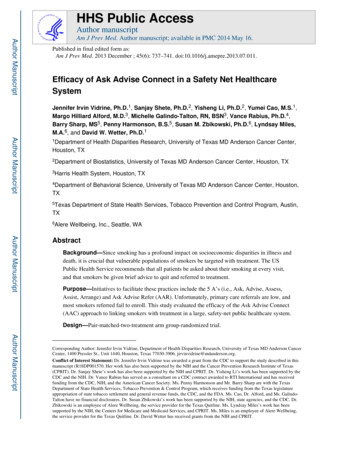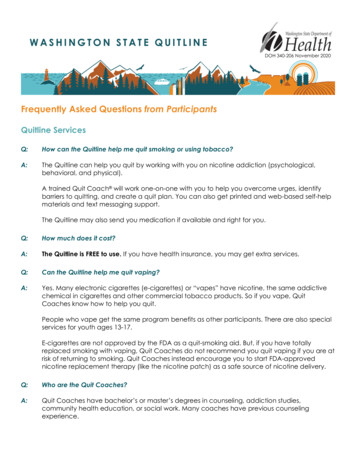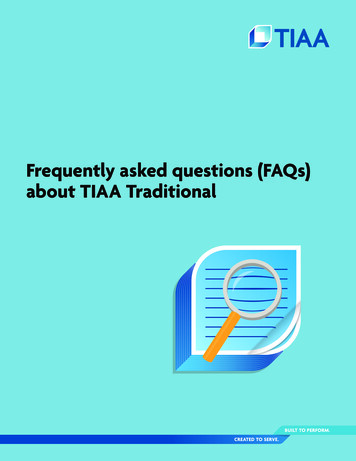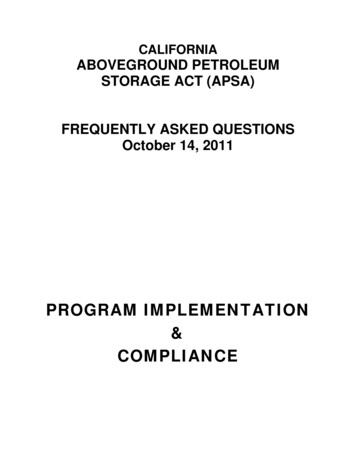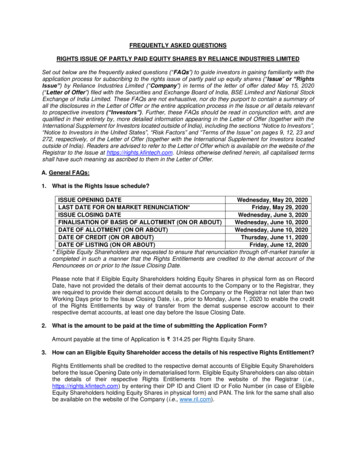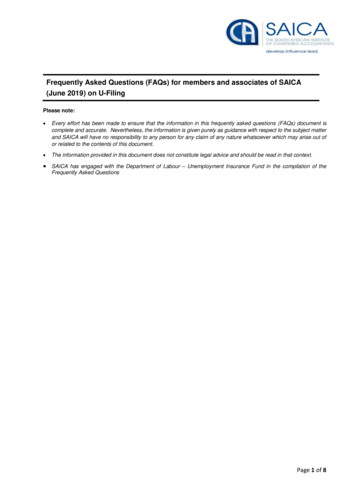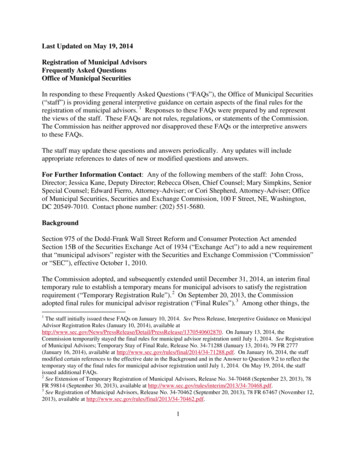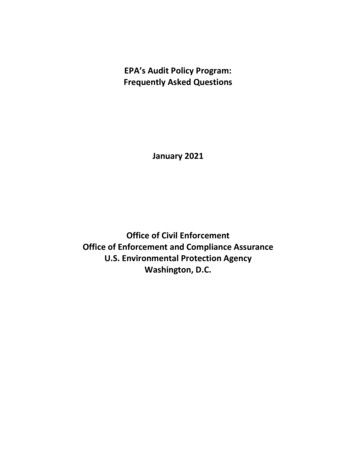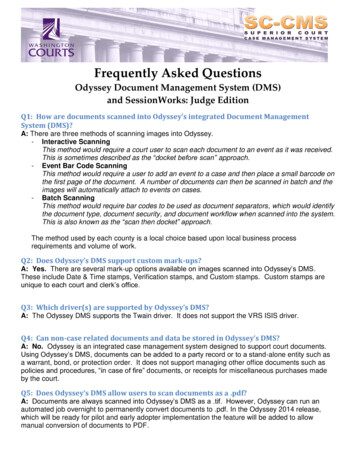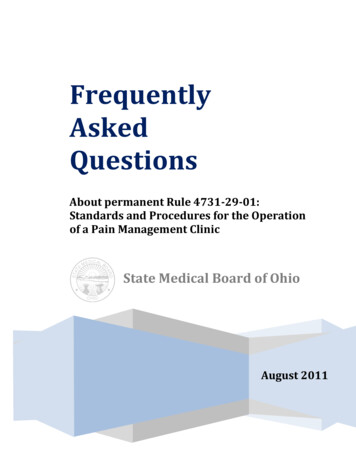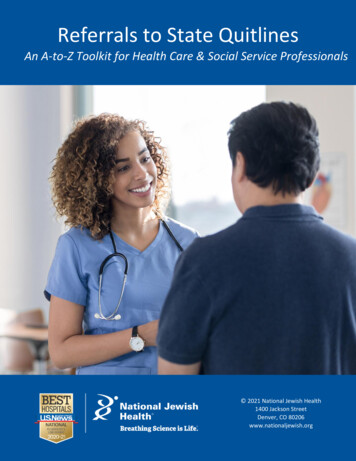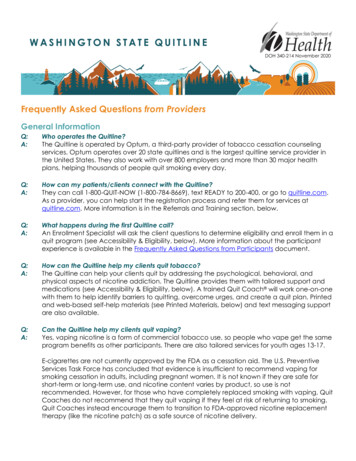
Transcription
DOH 340-214 November 2020Frequently Asked Questions from ProvidersGeneral InformationQ:A:Who operates the Quitline?The Quitline is operated by Optum, a third-party provider of tobacco cessation counselingservices. Optum operates over 20 state quitlines and is the largest quitline service provider inthe United States. They also work with over 800 employers and more than 30 major healthplans, helping thousands of people quit smoking every day.Q:A:How can my patients/clients connect with the Quitline?They can call 1-800-QUIT-NOW (1-800-784-8669), text READY to 200-400, or go to quitline.com.As a provider, you can help start the registration process and refer them for services atquitline.com. More information is in the Referrals and Training section, below.Q:A:What happens during the first Quitline call?An Enrollment Specialist will ask the client questions to determine eligibility and enroll them in aquit program (see Accessibility & Eligibility, below). More information about the participantexperience is available in the Frequently Asked Questions from Participants document.Q:A:How can the Quitline help my clients quit tobacco?The Quitline can help your clients quit by addressing the psychological, behavioral, andphysical aspects of nicotine addiction. The Quitline provides them with tailored support andmedications (see Accessibility & Eligibility, below). A trained Quit Coach will work one-on-onewith them to help identify barriers to quitting, overcome urges, and create a quit plan. Printedand web-based self-help materials (see Printed Materials, below) and text messaging supportare also available.Q:A:Can the Quitline help my clients quit vaping?Yes, vaping nicotine is a form of commercial tobacco use, so people who vape get the sameprogram benefits as other participants. There are also tailored services for youth ages 13-17.E-cigarettes are not currently approved by the FDA as a cessation aid. The U.S. PreventiveServices Task Force has concluded that evidence is insufficient to recommend vaping forsmoking cessation in adults, including pregnant women. It is not known if they are safe forshort-term or long-term use, and nicotine content varies by product, so use is notrecommended. However, for those who have completely replaced smoking with vaping, QuitCoaches do not recommend that they quit vaping if they feel at risk of returning to smoking.Quit Coaches instead encourage them to transition to FDA-approved nicotine replacementtherapy (like the nicotine patch) as a safe source of nicotine delivery.
Q:A:Who are the Quit Coaches, and what are their qualifications?Quit Coaches receive intensive new-hire training accredited by the Association for theTreatment of Tobacco Use and Dependence (ATTUD) Advisory Council, as well as ongoingtraining. Quit Coaches receive more than 300 hours of training in tobacco cessationcounseling, as well as ongoing training in motivational interviewing, cultural competence, andskills for working with specific populations. Quit Coaches who complete the initial new-hiretraining take part in a transition team for a minimum of 320 hours. On the transition team, theircounseling quality, consistency, and caller satisfaction are closely monitored. Quit Coachescontinue to receive training and education around the latest science on quitting andmedications, cultural competence, and new techniques.Quit Coaches have Bachelor’s degrees in counseling, addiction studies, community healtheducation, or social work. Some have graduate degrees, and many have previous counselingexperience. Quit Coaches are selected for strong communication skills and their ability todemonstrate empathy. Quit Coaches represent multiple age groups, various ethnicities andcome from a variety of backgrounds. They are also required to have been abstinent fromtobacco and nicotine for at least two years.Q:A:How effective is the Quitline?Quitline counseling is proven to double a person’s chances of quitting and – when paired withmedication (see Pharmacotherapy, below) – quitlines triple success rates. An evaluation of2018-19 Washington State Quitline services estimated that nearly 35 percent of participantshad quit tobacco within seven months of registering for services. The same evaluationestimated that, for every dollar spent on Quitline services, the state saves five dollars in lostproductivity, medical, and other costs; the Quitline yields a high return on investment, asfurther demonstrated by a Washington State Institute for Public Policy benefit-cost analysis.Q:A:Who funds the Quitline, and why am I just now hearing about it?The Washington State Department of Health (DOH) funds the Quitline with a federal grant fromthe Centers for Disease Control and Prevention (CDC). DOH has not received dedicated statefunding for the Quitline since 2011, and in 2020, the North American Quitline Consortiumranked Washington state last in the country on per-capita state quitline spending. Little to noresources have been available to promote the Quitline over the past decade, and providerswho started practicing in Washington state during this time are relatively unlikely to haveheard of the Quitline.Q:I’ve heard rumors that the Quitline has run out of funding and suspended services in the past.Are these rumors true?Yes, due to low budget and high demand for tobacco cessation services, DOH has needed tosuspend some services for months at a time. However, DOH has worked with the Quitlineservice provider and other partners to reserve DOH-paid services for uninsured andunderinsured individuals and, in turn, promote health plan compliance with Affordable CareAct implementation guidance (see Accessibility & Eligibility, below). The Quitline has notsuspended services since 2017, and DOH does not foresee a need to do this again.A:Accessibility & EligibilityQ:A:Can anyone in Washington state call the Quitline?Yes, but services vary by age, health insurance status, and other factors. Uninsured andunderinsured Washingtonians are eligible for at least five counseling calls and two weeks ofnicotine patches. A summary of current coverage, by health insurance status, is available /340-207-QuitlineCoverage.pdf
Q:A:I already refer my clients to the Quit For Life program. Why should I promote the Quitline?Promoting and referring to the Quitline connects clients to Optum, the company that operatesboth the Quitline and the Quit For Life program. To reduce confusion and streamlinepromotion and referral processes, DOH recommends that providers promote a single phonenumber (i.e., 1-800-QUIT-NOW) to all clients ready to quit commercial tobacco. For clients withQuit For Life in their health plan, Optum will triage their call, text, or referral to the Quit For Lifeprogram. All other clients will be eligible for the DOH-funded Quitline benefit or a separateprogram and will be triaged accordingly.Q:A:How often can people call the Quitline?Washington state residents can call the Quitline as needed. However, program enrollmentand offerings (including self-help materials and medications) vary by insurance status.Uninsured and underinsured Washingtonians are eligible for one program enrollment per year.Q:A:Does the Quitline conduct calls in other languages?Yes. In addition to English, there is a dedicated Spanish line answered by Spanish speakers. Thephone number for the Spanish line is: 1-855-DÉJELO-YA or 1-855-335-3569. Translation isavailable in over 240 languages and dialects; the Quitline connects participants to theinterpretive service. In addition, the Quitline offers a dedicated line for deaf or hard of hearingWashingtonians: 1-877-777-6534. For clients who primarily speak Chinese, Korean, orVietnamese, DOH recommends they call the Asian Smokers’ Quitline. Chinese (Cantonese and Mandarin): 1-800-838-8917 Korean: 1-800-556-5564 Vietnamese: 1-800-778-8440Q:A:Do participants have to verify documentation of U.S. citizenship to use the Quitline?No. As part of the registration process, participants will only be asked to provide a homeaddress in the state of Washington for mailing purposes.PharmacotherapyQ:A:Do Quit Coaches prescribe medication?No, Quit Coaches do not prescribe medication, but may recommend nicotine replacementtherapy (NRT) or other medication based on the participant’s health information, the latestscience, and the product manufacturer’s use instructions. The Quitline may offer to ship overthe-counter NRT, like nicotine patches, to participants as part of a program. A summary ofcurrent coverage, by insurance status, is available bs/340-207-QuitlineCoverage.pdfQuit Coaches receive ongoing training to correctly assess for health conditions andmedications that may affect use of NRT. The Quitline will not distribute nicotine replacementtherapy to pregnant women, youth under 18 (per federal law), or those for whom it may notbe medically appropriate without a medical override (a prescriber’s permission).Q:A:Is NRT available to all callers?No. NRT coverage varies by health plan and health conditions. The Quitline will also not doseand ship NRT to people for whom it may not be medically appropriate without a medicaloverride (a prescriber’s permission). Availability of free medication is subject to Quitlineeligibility and service levels.Q:A:Does the Quitline dose NRT for pregnant women?No. Pregnant women who are interested in using NRT should discuss this decision with amedical professional.
Q:A:Does the Quitline dose NRT for youth?No. Per federal law, the Quitline is unable to dose and ship NRT to youth; the FDA has notapproved NRT for youth under 18 years of age.Q:A:Can my client just call the Quitline to get NRT?No. Due to budget limitations, DOH currently makes counseling a prerequisite for NRT, so NRTshipments are always accompanied by a counseling intervention with a Quit Coach. Thechances of quitting increase dramatically when counseling is paired with medication. QuitCoaches are always available for additional support and discussion about NRT usage.Referrals and TrainingQ:A:Who can refer clients to the Quitline?Any provider can refer clients to the Quitline; there are no restrictions on who can make areferral. However, only HIPAA-governed facilities and organizations can receive referraloutcome reports.Q:A:How can I refer my clients to the Quitline?There are multiple ways to refer your clients to the Washington State Quitline, including: Online – Go to quitline.com, click the ‘Refer A Patient’ button in the top-right corner,and search for your clinic or facility. If your clinic/facility is not listed or the fax number isout-of-date, you can add a new clinic/facility record (there will be a link at the top ofthe search results). Once you have selected your clinic/facility, complete the referralform for the client. You may also help them register for services directly on quitline.com. Fax – Download the fax referral form. Complete the Provider Information section at thetop. Save a copy and/or print copies with your information pre-populated. Then, witheach client you refer, complete the Patient Information section, and ensure that theyprovide their initials where indicated and sign/date the bottom. Fax the completed,signed form to 1-800-483-3078.Once referred, your clients will receive a call from an Enrollment Specialist within 48 hours. Thenumber will show up as 1-866-784-8454 or 1-877-270-7867. If they miss the call, the Quitline willtry to reach them again later, but your clients can also call 1-800-QUIT-NOW at any time.You may also invite your clients to call 1-800-QUIT-NOW, text READY to 200-400, or go toquitline.com to start the registration process. This referral method is best for clients who are notyet ready to make a quit attempt. You can call the Quitline to request free promotionalmaterials to share with clients (see Printed Materials, below).The Quitline can also accept referrals via email and electronic health record submission.Contact Nick Fradkin, DOH Tobacco Treatment Consultant, at nick.fradkin@doh.wa.gov forquestions about setting up an electronic referral (“e-referral”) process.Q:A:How will I know if my client registered and enrolled in a program?Outcome reports are available for HIPAA-governed facilities and organizations. These reportsare sent via fax to providers who indicate they are a HIPAA-covered entity on the referral form.Outcome reports include helpful follow-up information, including whether the Quitline wasable to reach the client and, if so, whether the client enrolled in a program, the planned quitdate, and if screening criteria for cessation medications were met. You can use thisinformation to follow up with your client about their quit attempt at your next contact.
Q:A:Is there an online training I can review and/or share with my colleagues?Yes. A free online training is available at doh.wa.gov/quitlinetraining. Please note that thetraining is geared toward behavioral health providers, but the Quitline information and referralprocesses are applicable to all types of providers.Printed MaterialsQ:A:Where can I find promotional materials, like the business cards?You can call the Quitline to request a free shipment of 250 wallet cards and 50 rack cards. Youcan also request sample self-help materials (limit of one set of materials per clinic).Q:A:Are there self-help materials available to special populations?Yes. The Quitline has special materials available for pregnant women, American Indian andAlaska Native peoples, people identifying as LGBTQ, and people supporting another person’sefforts to quit. The Quitline also has special materials for people who use smokeless tobacco.Q:A:Are materials available in different languages?Yes. Self-help materials are available in English and Spanish. Also, the back side of the walletcard includes the Spanish phone number, 1-855-DÉJELO-YA.Q:A:Where can my clients learn more about the services?Your clients can call the Quitline to ask questions, go to quitline.com, and/or review theFrequently Asked Questions from Participants document.Other TopicsQ:A:How long has the Quitline been open?The Washington State Quitline started in 2000, when DOH received Master SettlementAgreement funding and partnered with Group Health Cooperative of Puget Sound to make itsFree & Clear tobacco cessation telephone counseling services available, for free, to allWashingtonians. These quitline services transitioned into a separate company, were lateracquired by Alere, and are now under the Optum name and Quit For Life brand. Althoughnames have changed over the years, the shared goal of this 20-year, public-privatepartnership is the same: To help Washingtonians quit commercial tobacco.Q:A:Who can answer other questions?You may call 1-800-QUIT-NOW and ask general questions about the Quitline or tobaccocessation, in general. You may also email Nick Fradkin, DOH Tobacco Treatment Consultant,at nick.fradkin@doh.wa.gov.To request this document in another format, call 1-800-525-0127. Deaf or hard of hearing customers, please call 711(Washington relay) or email civil.rights.@doh.wa.gov.
number (i.e., 1-800-QUIT-NOW) to all clients ready to quit commercial tobacco. For clients with Quit For Life in their health plan, Optum will triage their call, text, or referral to the Quit For Life program. All other clients will be eligible for the DOH-funded Quitline benefit or a separate program and will be triaged accordingly.
